SHORT WAVE DIATHERMY (SWD):
Definition:
- It is a treatment that uses electromagnetic energy to produce deep heating in joints and soft tissues.
- This form of heat can be applied to deeper structures than other forms of heat treatment.
- Thus SWD can effectively relieve joint pain, improve soft tissue healing and decrease the symptoms of osteoarthritis.
- Best Health Physiotherapists are knowledgeable and experienced in the appropriate application of SWD
- Shortwave diathermy uses high-frequency electromagnetic energy to generate heat.
- It may be applied in pulsed or continuous energy waves.
Diathermy means :
- Dia- through
- Thermy- heat
Benefits of heat :
- Increasing blood flow
- Relieving pain
- Improving the mobility of tissues as they heal
- Better flexibility
- Reduce inflammation

Frequency of Short – wave – diathermy :
- It is between 10000000 Hz – 100000000 Hz [ 10-100 MHz ]
- mostly used 27120000 [ 27.12 MHz ]
Wavelength of Short – wave – diathermy :
- It is between 30 – 3 m
- Mostly used 11 m
The machine circuit of Short – wave – diathermy :

- It is not possible to construct any mechanical device which causes sufficiently rapid movement to produce a high-frequency current so this type of current is obtained by discharging a condenser through an inductance of low ohmic resistance.
- The basic oscillator circuit consists of a condenser and an inductance, and currents of different frequencies are obtained by selecting suitable condensers and inductions.
- If a current of very high frequency is required the capacitance and inductance are small, while to produce a current of lower frequency a larger condenser and /or inductance are used
- In order to produce the high-frequency current, the condenser must be, made to charge and discharge repeatedly
- To achieve this the oscillator is incorporated into a valve circuit.
The patient circuit of Short – wave – diathermy :

- The circuit is coupled to the machine circuit by inductors i.e a matching high frequency current produced in the resonator circuit by electromagnetic induction.
- the oscillator and resonator circuit must be in resonance with each other,which requires that the product of inductance and capacitance must be same for both circuit.
- The electrodes and patient’s tissues form a capacitor,the capacitance of which depends on the size of the electrodes and on the distance and material between them,and so is different for each application
Indication of the circuit :
- An indicator light on the equipment either comes on or changes color .
- An ammeter wired in to the resonator circuit shows a maximum reading , which is diminished by turning the knob controlling the variable capacitor either way .
- A tube containing a small amount of neon gas placed within the electric filed between the electrodes or the end of The cable will glow at maximum intensity when the circuits are in resonance .
Method of application of Short – wave – diathermy :
- Capacitor field method
- Cable method
- Monode electrode method
Capacitor field method :
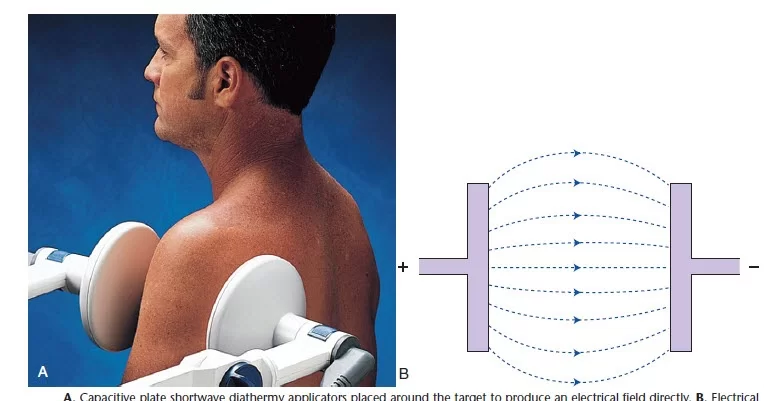
- Electrodes are placed on each side of the part to be treated, separated form the skin by insulating material.
- The Electrodes act as the plates of a capacitor, while the patient’s tissue together with the insulating material which separates them form the Electrodes form the dielectric.
- When the current is applied, rapidly alternating charges are set up on the Electrodes and give rise to a rapidly alternating electric field between them.
- The electric field influences the materials which lie within it
Cable method :
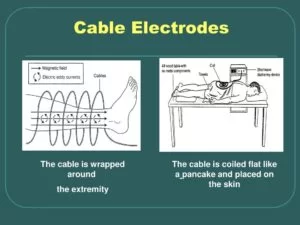
- When SWD is applied by use of cable the effect of the electric field may be used or that of the magnetic field or use may be made of both effects at the same time .
- The Electrodes consists of a thick , insulted cable which completes the patient ‘s circuit of the machine .
- The cable arranged in relationship to the patient ‘s tissue , but separated form them by a layer of insulating material .
- As the high – frequency current oscillates in the cable , a varying electrostatic field is set up between its ends and a varying magnetic field around its central part .
Monode electrode method :
- It bis works on the same principle as the cable .
- It consists of a flat helix of thick wire mounted in a rigid support .
- A condenser in parallel with the coil makes it possible to use a shorter length .
- Heating a produce by eddy currents in a region shaped like a hollow ring , but rigid support the electrode enables the electrode to be used with air spacing .
Types of Electrodes which is used in Short – wave – diathermy :
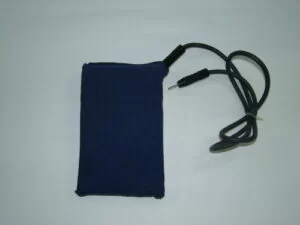
Flexible pads :
- Consist of metal Electrodes encased in rubber and produce an electrostatic field .
Space plates :
- Consist of a rigid metal Electrodes encased in.
- Perspex cover electrostatic field.
Coil or cable :
- Electrodes consists of a wire with plugs at either end creates Electromagnetic field.
The monode:

- Flat , rigid coil encased in plastic cover Electromagnetic field .
The diplode :
- Electrodes consists of a flat coil Electrodes encased in a perspex cover with two wings Electromagnetic field.
Size of Electrodes for Short – wave – diathermy:

- As a general rule the electrode should be rather larger than the structure that is being treated .
- The electric field tends to spread,particularly at the edges, resulting in a lower density of field in the resulting in the deep part of field than in the superficial tissue.
- If the electrodes are large,the outer part of the field where the spread is greatest is deliberately not utilized;
- The structure to be heated lies in more even central part of the field.
- ex. treatment of the trunk electrode should be as larger as possible, while for a limb that should be rather larger than the diameter of the limb.

- If part of limb between the Electrodes is smaller in diameter than the Electrodes = the lines of force bend in towards the limb
- If the diameter of the Electrodes is smaller than that of the limb = the lines of force spread in the tissues , causing more heating of the superficial than the deep structures.
- If the diameter of the Electrodes is far large than that of the limb = some of the lines of force by -pass it completely , so electrical energy is wasted though a satisfactory heating effect may be obtained.
- Both Electrodes should be of the same size.
- If they are of different sizes they form a capacitor with different-sized plates, so different quantities of electricity are required to charge them to the same potential.
- This puts an uneven load on the machine and may give rise to difficulties in tuning.
Space of Electrodes for Short – wave – diathermy:
- The spacing between the Electrodes and the patient,s tissue should be as wide as the output of the machine allows.
- The material between the Electrodes and the skin should be of low dielectric constant, the air being the most satisfactory.
For space used to :
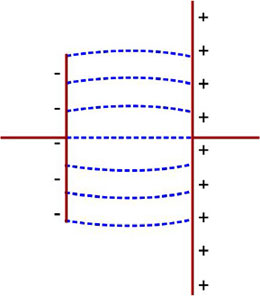
- Wrapping a flexible pads in towel.
- Flat felt spacing pads between pad Electrode and skin
- Air when using space plates .
- Small spacing = particularly with material high dielectric constant.
- Wide spacing = particularly with material low dielectric constant.
- If one Electrode is placed nearer to the skin than the other Electrode, there is a greater heating effect under the closer Electrode than the further one.
- So the lines of force under the further Electrode have a greater distance in which to spread before reaching the skin than those under the nearer one.
- Therefore cover a greater area of skin and their density is less than under thye nearer Electrode.
- On spacing must be taken care that the distance between the Electrodes is greater than the total space.
Position of Electrode for Short – wave – diathermy:
The position of the Electrodes should be chosen with the aim of directing the electric field through the structure to be treated.
- High impedance structure = Electrode as far as possible to electric field
- Low impedance structure = Electrode parallel to electric field
- If possible Electrodes placed over even surface of the body.
- Irregular surface = field tends to concentrate on more prominent part
- Regular surface = reduced the concentration by using the wide spacing
Contra-planer position :

- Mostly used for deeply placed structures.
- The Electrodes are placed over opposite aspects of the part of the body which part has to be treated.
- So that the electric field is directed through the deep tissue.
- Electrodes must be parallel to the skin and do not close to each other.
- Ex – trunk or limb
Co-planer position :

- Mostly used for superficial structures.
- The Electrodes are placed side by side on the same aspects of the part of the body which part has to be treated .
- Provide adequate distance between Electrodes, so that pathway of tissue offers less impedance.
- Ex – spine
Cross -fire position :

- It is used for treat the walls of cavities containing air, deeply placed structures which is lie in extensive vascular area.
- On this position half treatment is given in one aspect and second half treatment given is opposite aspect of the first .
- So that electric field lies on right angle to the obtained during the first part of the treatment.
- Ex – for knee joint half treatment = medial and lateral aspect and half treatment = anterior and posterior aspect
- Another ex – frontal , maxillary, ethmoid sinuses and pelvic organs
- For face one thing mast be carefully check if patient wear contact lenses, during treatment remove the lenses because heating effect melting of lenses.
Mono polar position :
- Mostly used for superficial lesion.
- The active electrode is placed over the site of the lesion and the indifferent electrode is applied to some distant part of the body.
- A separate electric field is set up under each electrode.
- The lines of force radiating from the electrode.
- Thus the density of the field becomes less as the distance form the electrode increase.
Techniques of the Short – wave – diathermy:
Testing of the machine :
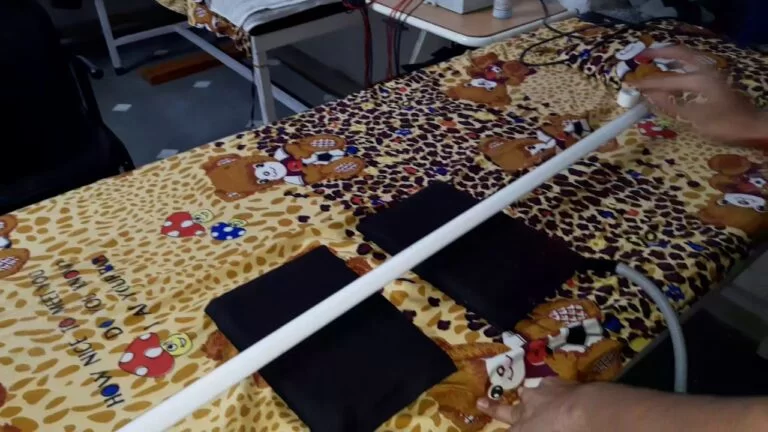
Always before use the machine carefully check the machine.
Condenser electrode :
- Electrodes is placed opposite to each other with a gap in between.
- The operator places her hand between the electrodes, switches on and tunes the machine ;
- Then increase the current until comfortable warmth is felt.
Cable electrode :
- Place in single loop and tested with a neon tube.
- Which lights up when two circuit are in resonance.
Preparation of the Patient :
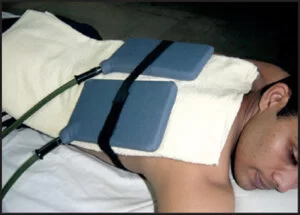
First of all check the all contraindications and also check the skin sensation.
Patient are fully comfortable and supported which is made form wooden and free from metals.
Mostly used the couch , chair or table for support.
Remove all the jewelry,coins, and metallic items from the patient.
Wash the skin over the treatment area.
Wounds and sinuses must be cleansed and covered with a dry dressing.
Monitoring the treatment :
- Before starting treatment,all meters of apparatus should be on zero position (starting position ).
- Select the power level according to the patients condition.
- Increase the intensity gradually till the desired heating level is reached.
- The physical therapist should remain within call of the patient during the whole treatment of period.
- At the end of the treatment, the control knobs are returned to zero position, current switched off and the electrodes removed.
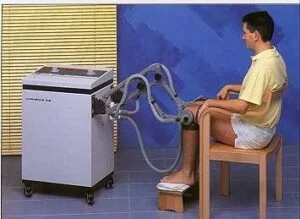
Dosage of the Short – wave – diathermy machine :
Most of the case intensity of the machine is comfortable warmth of the machine.
Duration = 20 – 30 minutes [ for inflammatory Chronic lesion – at least 30 minutes ]
Treatment must be given daily or alternate day.
For acute inflammation :
- Less intensity
- More frequency
- 5-10 minutes
- Twice a day give to a treatment
Inflammation in confined space [ air sinuses of face ]
Most important that avoid the excess treatment
Rise in tension in such an area seriously aggravates the symptoms.
Physiological Effect of Short Wave Diathermy:
The effect is to follow the step :
- Heat Produce
- Increases diameter of blood vessels
- Increase Blood circulation
- Remove Waste Products
- Increases Nutrients Supply in the affected area
- Relief Pain/Reduce Muscle Spasm
Therapeutic use of Short Wave Diathermy :
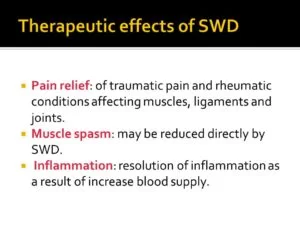
Effect on inflammation :
- The dilatation of arterioles and capillaries results in an increased flow of blood the area,
- Making available increased supply of oxygen and nutritive materials
- Also bringing in more antibodies and white blood cells.
- Increases the exudation of fluid into the tissues. these effects help to bring about the removal of waste product
- This effects help to bring about the resolution of inflammation.
- Acute stage = normal dose
- Sub – acute stage = stronger dose
- Chronic stage = thermal dose
Effects in bacterial infection :
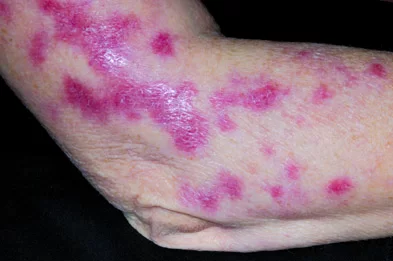
- Inflammation is the normal response of the tissue to the presence of bacteria.
- The principal features being vasodilatation, exudation of fluid into the tissue, and an increase in concentration of white blood cells and antibodies in the area.
- Heating the tissues augments these changes.
- So reinforces the body’s normal mechanism of dealing with the infecting organism, therefore short wave diathermy may be of value in the treatment of bacterial infections such as boils, carbuncles and abscesses.
- Bacteria can be destroyed directly by heat.
- But it would be impossible to raise the body tissue to the necessary temperature without causing damage to the tissue itself.
Traumatic conditions :
- The effect of SWD on traumatic conditions same as the inflammation because lesion produce inflammation.
- Exudation of fluid into the tissue and increased flow of blood to the area assist in the removal of waste products.
- Improved blood supply so that it assists the healing.
- Recent injuries = same as acute stage treatment.
- Stiff joint & other after-effects of injury = stronger dose.
Reducing healing time :
- To promote the healing of for instance a wound
- An increased blood supply to the tissues may be of assistance, provide that the vascular response to heat are normal.
Relief of pain :
- It is found that a mild degree of heating is effective in relieving pain.
- Presumably as a result of a sedative effect.
- It has been suggested that pain may be due to the accumulation in the tissue of the waste products of metabolism
- Increase flow of the blood and assists in removing of these substance.
- Strong superficial heating = relives pain by counter – irritation.
- inflammatory process = relives pain by resolution of the inflammation.
Effects on muscle tissue :
- Effect of heating on muscle induce muscle relaxation.
- So SWD is used for the relief the muscle spasm.
- Increased efficiency of muscle action.
Indication of Short Wave Diathermy :
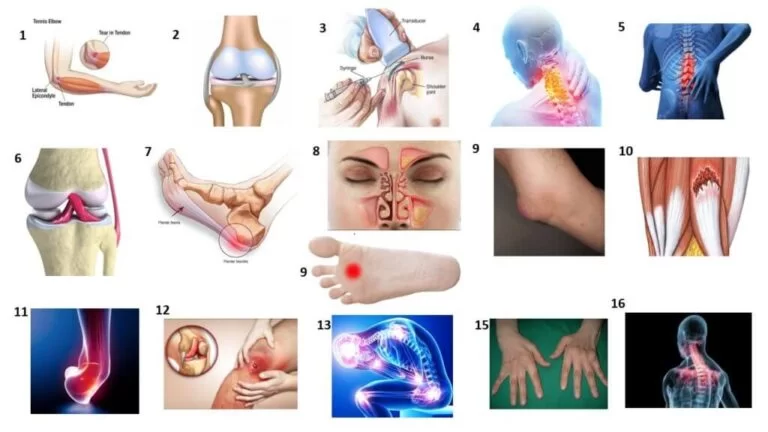
Disorder of Musculoskeletal System :
- Sprain (ligament)
- Strain (Muscle)
- Capsular lesion (Frozen shoulder)
- Degenerative joint disease (OA, chronic rheumatoid arthritis )
- Joint stiffness
- Muscle and tendon tears
- Haematoma
Inflammatory Condition [ chronic or acute ]:
Tendinitis
Bursitis
Tenosynovitis
Boils
Pelvic conditions
Infected surgical incision
Sinusitis
Carbuncles
Contraindication of Short Wave Diathermy :
Haemorrhage:
- The heating of tissue by a diathermy current causes dilatation of blood vessels.
- So it should not be employed directly after an injury or in any case where hemorrhage has recently occurred.
- It should not be applied to the abdomen or pelvis during menstruation
- Nor should not be used for conditions in which hemorrhage might occur, such as gastric or intestinal disease associated with ulceration or hemophilia.
Venous thrombosis or phlebitis :
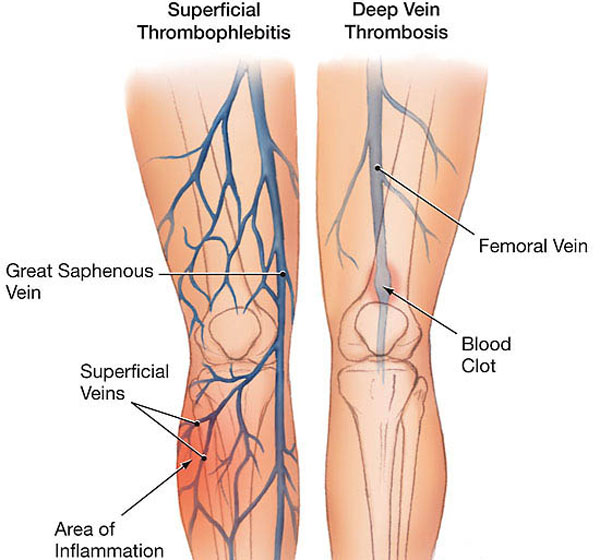
- These conditions contraindicate the application of SWD to the area drained by the affected vessels.
- As the increased flow of blood may dislodge the clot or aggravate the inflammation.
Arterial disease :
- Diathermy should not be applied to parts that have a defective arterial blood supply.
- The inability of the circulation to disperse the heat could result in an increase in temperature to a level that could produce a tissue burn.
- Unsatisfied tissue demand for nutrients could precipitate gangrene.
Pregnancy :
- Diathermy should not be applied to the abdomen or pelvis during pregnancy.
Metal in the tissues :

- Metal may be embedded in the tissue.
- It is dangerous to burn.
- Because it is the concentration of the electric field.
Disturbed skin sensation :
- It is safer to avoid the application of diathermy to areas where there is a loss of skin sensation.
Tumors :
- Short-wave diathermy should not be applied in the region of malignant growths.
- The increase in metabolism resulting from the increase in temperature could accelerate the rate of growth.
X-ray :
- X-ray devitalize the tissues and render them more susceptible to damage.
- Short wave diathermy should therefore not be applied to areas recently exposed to therapeutic doses of x-ray.
Patients at particular risk :
- It is unsafe to apply swd to patients who are unable to understand the degree of heating required and the necessity of reporting excessive heating.
- For this reason, small children and mental defectives are not suitable for treatment.
- Similarly, it is not safe to treat unconscious patients or those who are liable to lose consciousness, such as epileptic.
Who’s Unqualified for Short Wave Diathermy?
- Pacemaker
- Prosthesis
- Intrauterine device (IUD)
- Cancer
- Reduced skin sensation
- Peripheral vascular disease
- Tissue with restricted blood supply (ischemia)
- Infections
- Fractured or broken bones
- Bleeding disorders
- Severe heart, liver, or kidney conditions
- Low skin sensation
- Pregnancy
- Perspiration
- Wound dressings
Danger of Short Wave Diathermy :
Burn :
- Heat burn can be caused by SWD.
- So before treatment warn the patient
- Severe cases = coagulation & blistering is liable destruction of the tissue – white patches
- Milder cases = tissue is not destroyed & – a bright red patch
- If the damage occurs as soon as possible remove the electrodes.
Causes of burn :
- The concentration of the electric field
- Use of excess current
- Hypersensitivity of the skin
- Impaired blood flow
- Leads touching the skin
Scalds :
- It is caused by moist heat.
- May occur if the area being treated is damp.
Overdose :
This causes an increase in the symptoms, pain, and acute inflammation within a confined space.
At that time reduce the intensity of subsequent applications.
Precipitation of gangrene :
- Heat accelerates chemical changes including metabolic processes in the tissues.
- So increasing the demand for oxygen and gangrene is developing.
- Heat should never be applied directly to an area with an impaired arterial blood supply.
Electric shock :
- It can occur if contact is made with the apparatus circuit with the current switched on.
- But modern apparatus is usually not possible.
Sparking :
- It occurs if one of the electrodes is touched while the current is applied.
- So the patient must be warned not to touch electrodes.
Faintness :
- It is produced by hypoxia of the brain following a fall in blood – pressure.
- It mostly occurs in extensive treatment
Giddiness :
- Any current applied to the head may feel giddiness from the effect on the contents of the semicircular canals.

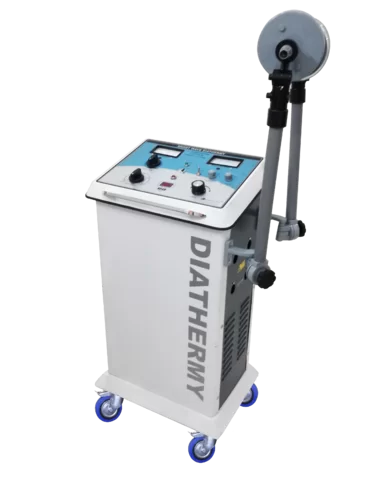
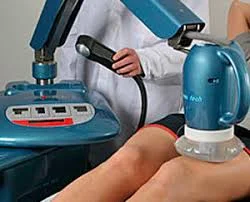
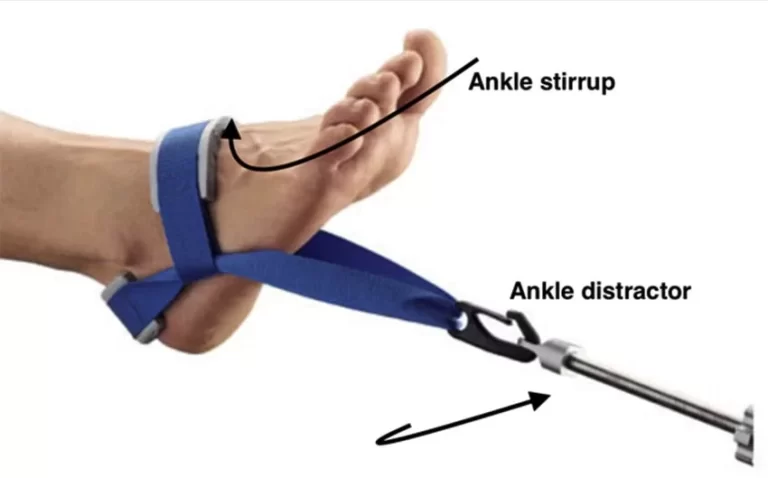
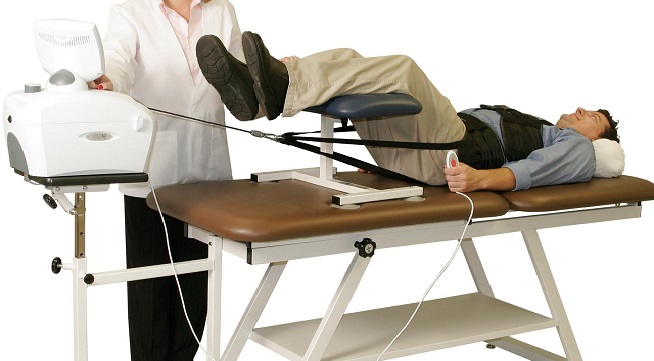
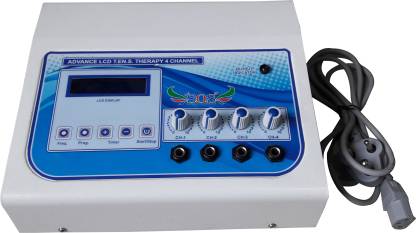

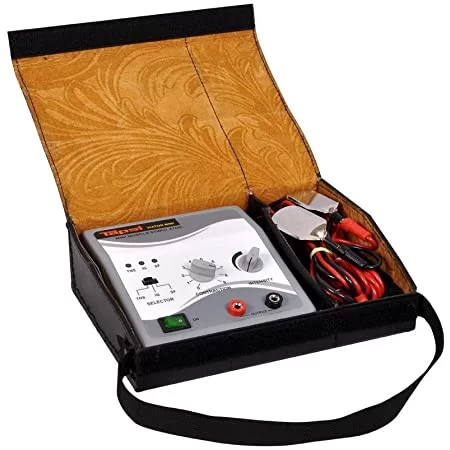
Short wave diathermy is widely used in India by Physiotherapist to relive pain, muscle spasm and swelling of the joints, This deep heating machine helps also helps to healing of the tissues that are located deep to the body.